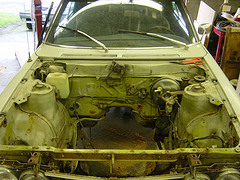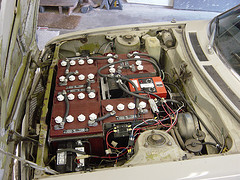|
While I was finishing up my speedster project, I started to look around for my next project. I had come across the electroauto.com website a few times and was intrigued about the idea of converting a car to electricity. I had ideas about getting an old VW Bus, and cramming it full of batteries, or maybe making the speedster a "dual fuel" car, that could be converted over a weekend, and then back. The biggest problem I had, was lack of space. Our 2 car garage was occupied by Kate's Saab, and the Speedster. My truck was in the driveway. Any sort of project car would need to live in the garage, and Kate was not about to give up her spot, and there was no way the Speedster was going to live outside on the street. So, the idea of an electric car got put on the back burner.

Then we went to Hessel for a few weeks in the summer to Kate's family house. Her Grandmother had passed away a few years earlier, and Kate's mom was trying to tie up some loose ends and consolidate some things at the house. One of these loose ends was a 1974 Toyota Celica with 50k miles. Kate's Grandmother was the only owner. Kate's mom (Margy) was trying to sell the car. When we went to drive it out to the main road with a for sale sign on it, the car wouldn't start. Something in the carb was stuck and it was flooding big time. I started to think, maybe this could be the doner car for my electric project. After a little negotiation, we became the new owners of the Celica, and paid to have it shipped back to Seattle. The car still had North Carolina plates on it, which had expired in 1997 (it was 2005).

The Celica arrived in Seattle in early September, and shortly afterwards, I took the Speedster up to Orcas Island to store for the winter at my Dad's house. The Celica then went into the garage and I ordered the DC Deluxe Univeral Kit from Electro Auto. This was around the time of Katrina, when gas prices went out the roof. I think everyone had the idea of converting to electric, and it took until almost January to get all the part of the kit. It didn't matter too much because my son Sam was born in October, so I didn't have much free time to work on the car.

Taking out the gas engine and transmission was not very hard, in fact, it was almost routine given what I did with my jeep. The big question in the beginning was how many volts? 96, 104, 120, 144. The most economical battery options are golf cart lead acid batteries. 96 volts seemed like it might not be enough, so I started to figure what would be needed for 120 volts. Going with 6v batteries would mean I needed to fit 20 batteries. 8v would mean 15, and 12v would mean just 10. But, I had heard that 12v deep cycle were not as good as going with the 8v or 6v. After doing some measuring, it looked like I would be able to fit 7 batteries, in the front, and 8 in the back with room to spare. This meant going with the 8v batteries, and a little less weight. It also turns out the 8v batteries cost less than the 6v. I ended up getting Trojan T-875 8V Deep Cycle Batteries. The "Convert It" book that comes with the Kit, and is also available separately on the electro auto site is a must buy and full of lots of good important info. Most of the work is in building the battery boxes. Having your batteries first is a must. Eventually I got everything installed an was able to go around the block. The accelleration and power is not anything like a gas car, maybe like an old stock VW Bug, but nothing like a Speedster, but it is not about speed, it is about getting from A to B in a clean, cheap way.

In order to figure out exactly how much electricity I was using to charge the batteries, I got a kill-a-watt meter, which I would plug in-line before the charger. As for range and speed, I have gone to work and back (a round trip of 25 miles) without a problem, and figure I could probably go 50 miles round trip. 55 mph is not a problem (it just takes a little longer to get there, maybe 30 seconds instead of 10), and I have gone up to 70 on a little downhill. Pictures of the project can be found at http://flickr.com/photos/79586203@N00/tags/electric/ Updates - 5/21/06After driving the "Magic Car" (as Arla calls it), for about a month, battery voltage is not the limiting factor in my range, controller heat is my problem. Originally I had the control and charger mounted together in the front between the batteries in the middle. The controler was mounted on some blocks of aluminum to try and help disipate the heat. But a couple times during the end of each of my trips to or from work, I would get some cutting out and loss of performance, and sometimes could hear the controller whining (which is a sign it is overheating). I first tried to move the charger to the back, and mount the controler more in the middle with the hope of getting more air flow around the controler. I also found a couple heat sinks from a PIII Xenon processors at work that were not being used any more, along with 6 cpu fans. I used some ABS cement to glue all the fans together, and mounted the heat sinks to the bottom of the controller and wired up the fans to move some air. That didn't help. About the same time I ordered an amplifier temperature guage, which I installed on the bottom of the controller so I could see just how hot things where getting. Towards the end of my trips, the controller was getting around 110 to 115 degrees F, at which point it was not happy. On a warm day in May, the air temperature was around 85, which made the controller peak out at 117 on the trip home. The next thing I'm going to try thanks to a suggestion from the Seattle EV group, is to put an air scoop in the hood, right over the controller. I found lots on ebay. I also found a bigger aluminum heat sink on ebay as well. I then turned the controller upside down, so the heat sink was facing up, got rid of the CPU fans, and will soon cut a hole in the hood for the air scoop. Hopefully this will keep things cooler and I can get a better idea of my range and performance. The following log attempts to record the costs of using electric vs gas. Charging Log
| Date |
Miles | Kwh | ChargeTime | Miles/Kwh |
| 4/2 | 23.1 | 9.54 | 9:37 | 2.421 | | 4/4 | 27.8 | 13.44 | 14:51 | 2.068 | | 4/6 | 24.9 | 12.11 | 15:30 | 2.056 | | 4/10 | 27.3 | 12.38 | 14:39 | 2.205 | | 4/11 | 24.9 | 11.45 | 14:32 | 2.175 | | 4/13 | 16.4 | 9.62 | 16:35 | 1.705 | | 4/19 | 24.8 | 10.73 | 13:27 | 2.311 | | 4/20 | 26.8 | 11.29 | 13:22 | 2.374 | | 4/22 | 8.1 | 4.87 | 9:22 | 1.663 | | 4/23 | 25.2 | 10.60 | 13:18 | 2.377 | | 4/26 | 12.5 | 7.45 | 12:52 | 1.678 | | 4/27 | 28.1 | 11.97 | 10:34 | 2.348 | | 5/2 | 28.5 | 12.56 | 13:17 | 2.269 | | 5/3 | 24.6 | 11.18 | 11:55 | 2.200 | | 5/4 | 25.2 | 11.96 | 10:42 | 2.107 | | 5/5 | 24.9 | 11.22 | 16:19 | 2.219 | | 5/6 | 8.6 | 4.60 | 9:07 | 1.870 | | 5/8 | 26.5 | 11.14 | 13:03 | 2.379 | | 5/9 | 7.5 | 4.48 | 9:54 | 1.674 | | 5/10 | 25.2 | 11.96 | 10:42 | 2.107 | | 5/11 | 21.7 | 11.57 | 14:26 | 1.876 | | 5/14 | 6.8 | 4.58 | 6:38 | 1.485 | | 5/15 | 27.2 | 10.30 | 10:26 | 2.641 | | 5/16 | 24.5 | 10.66 | 10:15 | 2.298 | | 5/20 | 9.9 | 6.56 | | 1.509 | | 5/22 | 26.1 | 11.39 | | 2.291 | | 5/23 | 28.5 | 12.06 | | 2.363 | | 5/24 | 32.3 | 13.44 | | 2.403 | | 5/25 | 31.9 | 13.44 | | 2.374 | | 5/30 | 24.6 | 10.35 | | 2.377 | | 5/31 | 11.8 | 6.18 | | 1.909 | | 6/1 | 24.5 | 10.52 | | 2.329 | | 6/2 | 35.2 | 14.76 | | 2.385 | | 6/4 | 6.5 | 4.25 | | 1.529 | | 6/5 | 26.9 | 10.96 | | 2.454 | | 6/6 | 7.8 | 4.91 | | 1.589 | | 6/8 | 38.3 | 17.97 | | 2.131 | | 6/9 | 31.6 | 12.56 | | 2.516 | | 6/12 | 24.7 | 11.59 | | 2.131 | | 6/13 | 28.5 | 11.96 | | 2.383 | | 6/14 | 25.2 | 10.43 | | 2.416 | | 6/15 | 27.4 | 12.01 | | 2.281 | | 6/19 | 26.1 | 11.13 | | 2.345 | | 6/20 | 24.8 | 10.58 | | 2.344 | | 6/21 | 27.4 | 11.46 | | 2.391 | | 6/22 | 25.2 | 10.06 | | 2.505 | | 6/23 | 26.6 | 10.06 | | 2.644 | | 6/26 | 23.2 | 9.71 | | 2.389 | | 6/27 | 3.7 | 3.24 | | 1.142 | | 6/28 | 23.2 | 9.58 | | 2.422 | | 7/23 | 15 | 8.16 | | 1.838 | | 7/24 | 49.9 | 12.48 | | 3.998 | | 8/1 | 46.1 | 13.5 | | 3.415 | | 8/2 | 47.7 | 13.9 | | 3.432 | | 8/3 | 46.9 | 17.75 | | 2.642 | | 8/7 | 47.0 | 18.0 | | 2.611 | | 8/8 | 44.7 | 15.48 | | 2.888 | | Totals | 1440.3 | 612.09 | | 2.353 |
Summary| Price of electricity (in Seattle) | $0.07/kwh | | Total cost to charge electric car | $42.846 | | Price per mile | $0.030 | | Price of gas (in Seattle) | $3.18/gallon | | To get this same price per mile using Gas you would need to get... | 106/mpg |
Related Links |